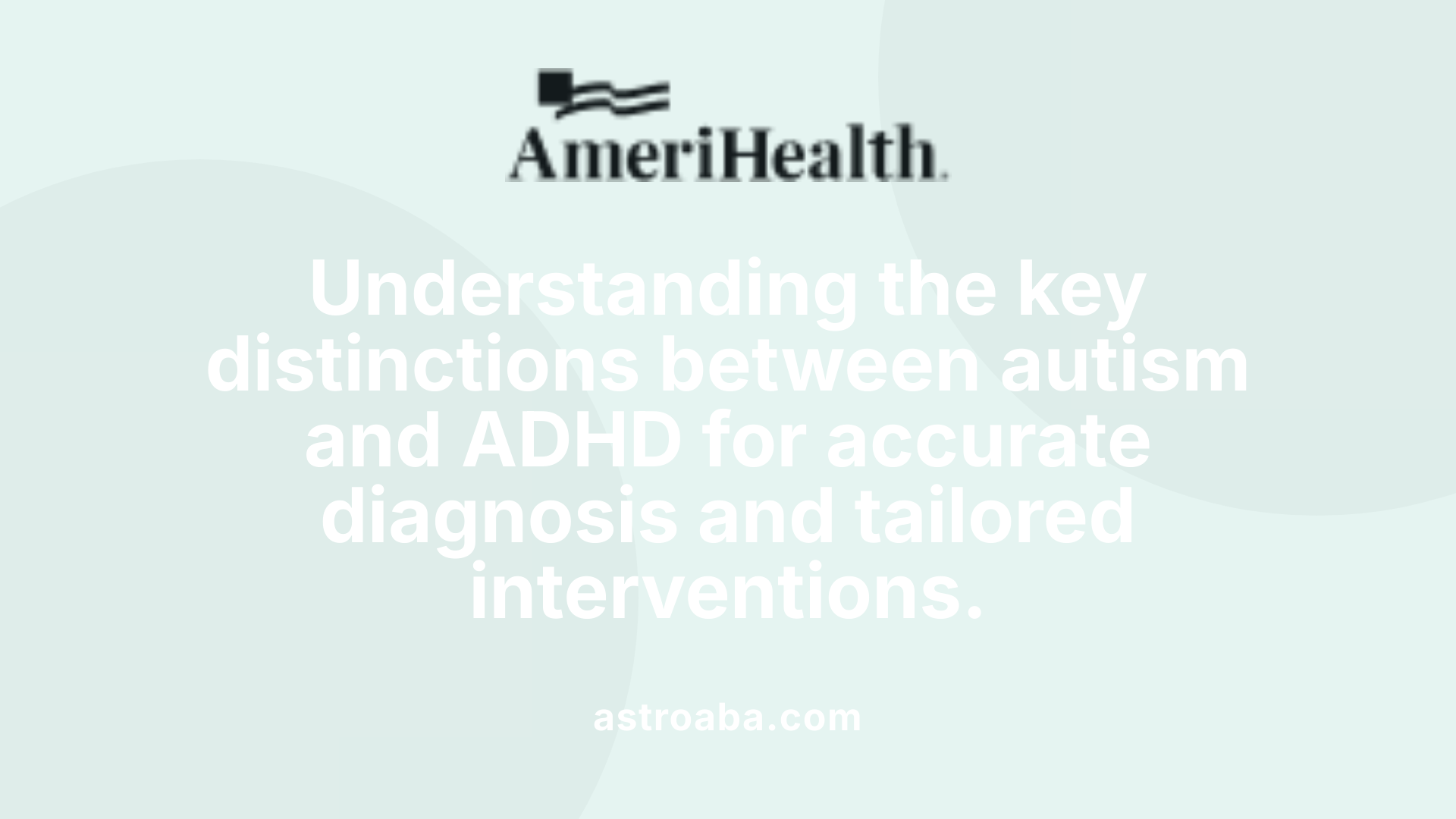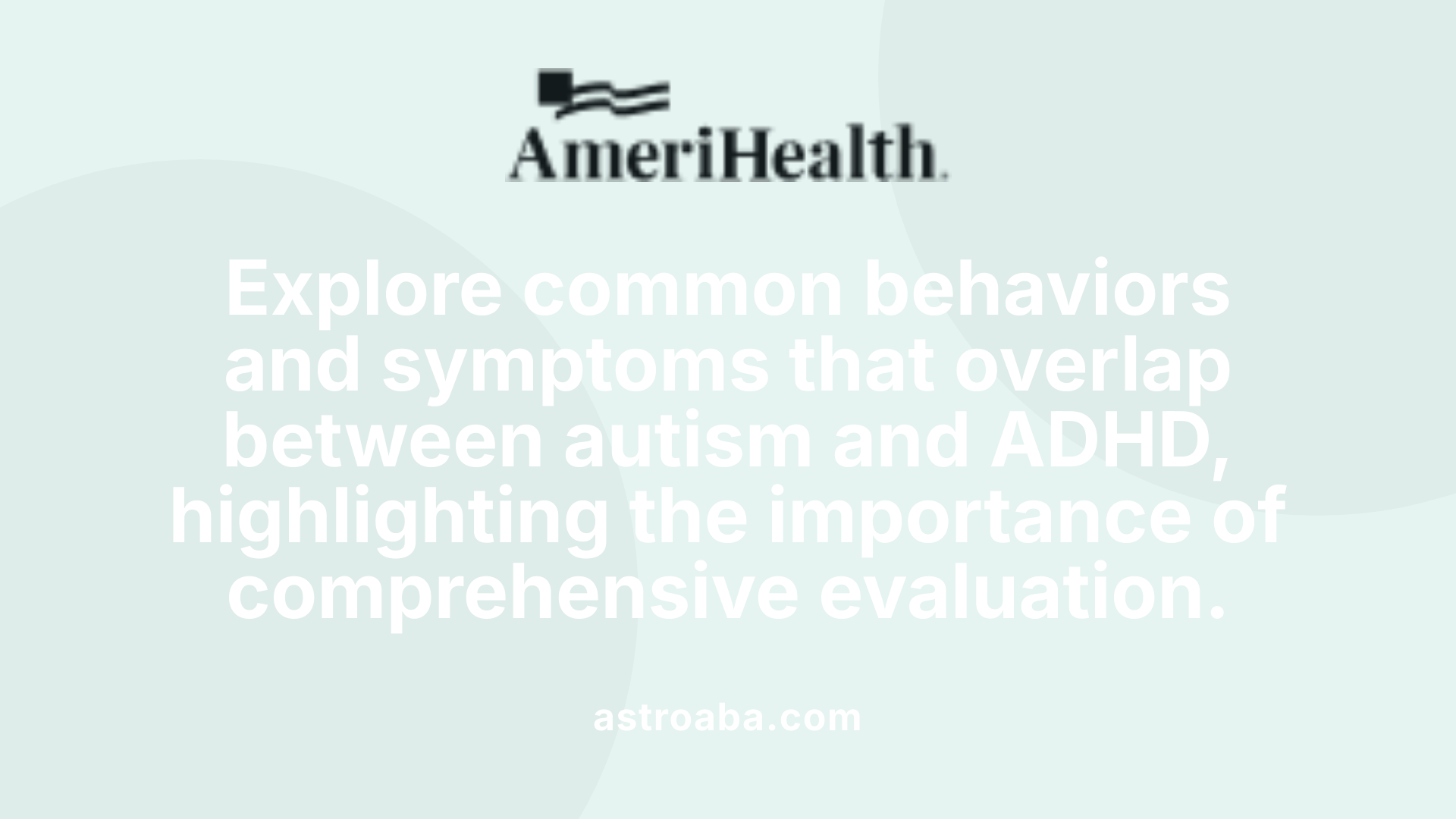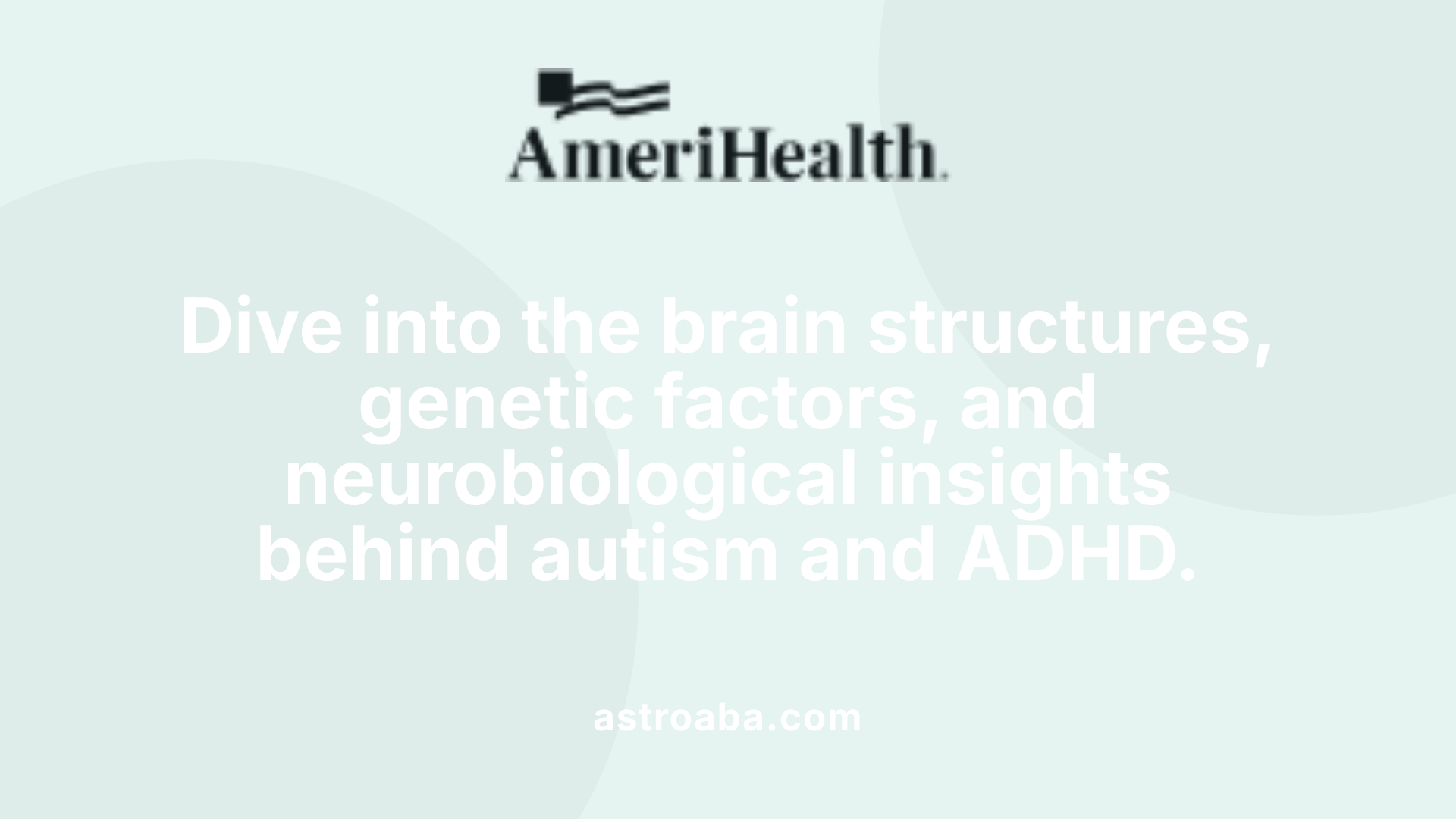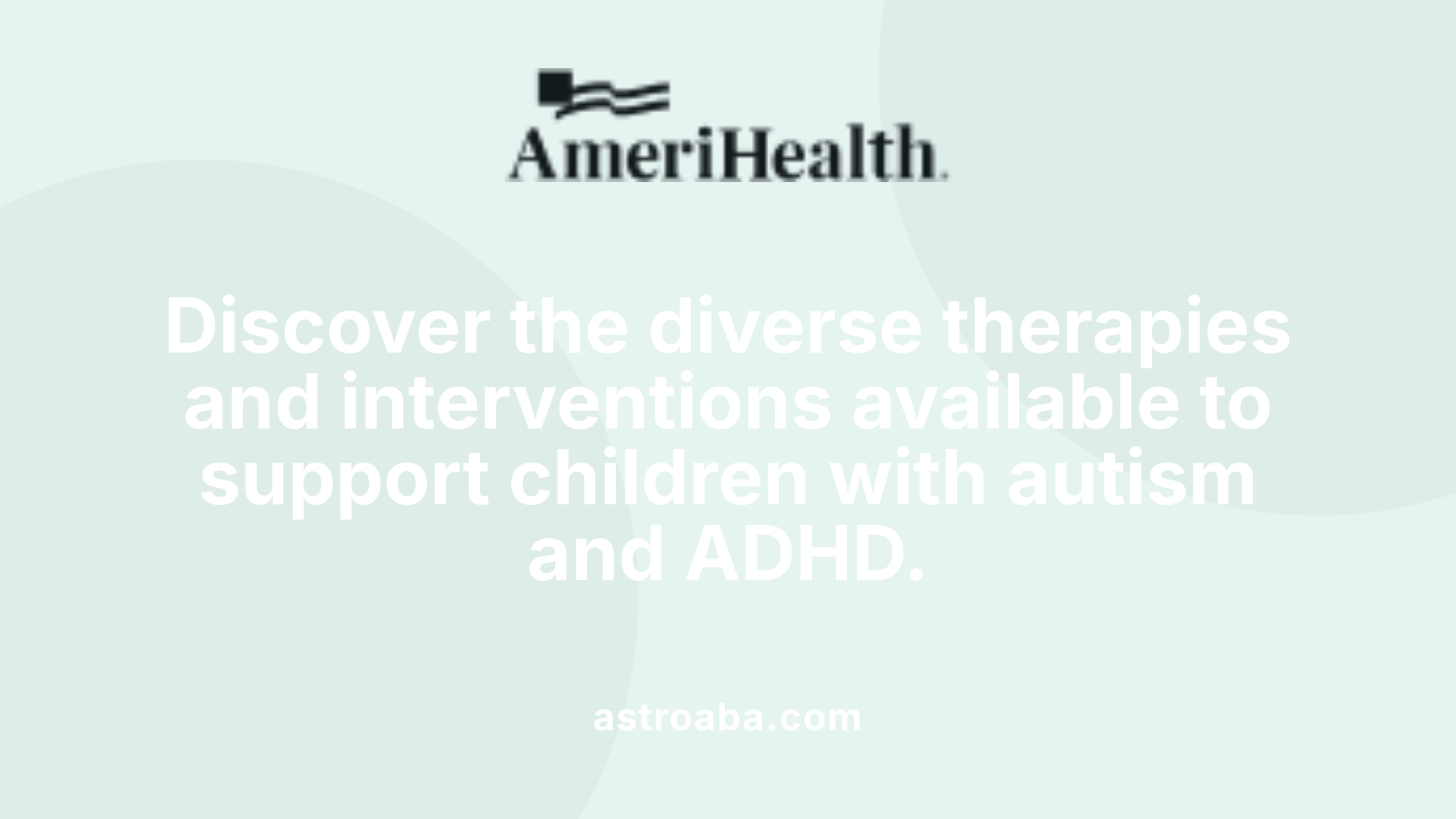Autism vs. ADHD
Understanding the Distinction and Overlap of Neurodevelopmental Disorders

Deciphering Autism and ADHD: Key Insights
Autism Spectrum Disorder (ASD) and Attention-Deficit/Hyperactivity Disorder (ADHD) are two prevalent neurodevelopmental conditions that, despite sharing some overlapping features, differ significantly in their core symptoms, diagnosis, and management. This article explores the main differences, similarities, neurobiological underpinnings, and effective ways to distinguish between these conditions, providing a comprehensive guide for clinicians, educators, and families navigating these complex diagnoses.
Core Differences in Symptoms and Characteristics

What are the main differences between autism spectrum disorder and ADHD?
Autism spectrum disorder (ASD) and attention-deficit/hyperactivity disorder (ADHD) are both neurodevelopmental conditions that share some similar traits but differ fundamentally in their core symptoms. Children with ASD primarily struggle with social communication and interaction. They may avoid eye contact, have difficulty understanding social cues, and engage in repetitive behaviors or routines. Many prefer sameness and can become distressed when routines are disrupted.
In contrast, children with ADHD often face challenges related to attention, hyperactivity, and impulsivity. They are typically restless, often talk excessively, and may interrupt conversations or have trouble waiting their turn. While both conditions may involve difficulties with executive functions, ADHD symptoms are more centered around difficulty maintaining focus, controlling impulses, and managing restless energy.
Diagnosis hinges on careful behavioral observation, developmental history, and standardized questionnaires. It’s also common for children to have both conditions, a situation sometimes referred to as AuDHD, which can complicate diagnosis and treatment strategies.
Treatment methods vary; autism typically benefits from behavioral, speech, and occupational therapies aimed at improving social skills, whereas ADHD often responds well to medication, behavioral therapies, and coping strategies. Recognizing the distinct characteristics of each condition helps clinicians develop tailored intervention plans for affected children.
Shared Traits and Overlapping Symptoms

What are the common symptoms and diagnostic criteria for autism and ADHD?
Autism spectrum disorder (ASD) and attention-deficit/hyperactivity disorder (ADHD) are distinct neurodevelopmental conditions, but they share several traits that can make diagnosis challenging. Autism is characterized by persistent difficulties in social communication and interaction, often from early childhood. Children with autism may struggle with reciprocal conversations, making eye contact, and understanding social cues. They also tend to engage in repetitive behaviors, insist on routines, and show strong focus on specific interests.
ADHD, on the other hand, primarily involves issues with attention, impulsivity, and hyperactivity. Children with ADHD may talk excessively, interrupt others, and find it hard to stay focused on tasks. They also often display impulsive behaviors, such as difficulty waiting their turn or acting without thinking.
Despite these differences, both conditions can manifest in similar behaviors, such as inattention, difficulty with executive functions, and behavioral regulation problems. For example, children with both ASD and ADHD might exhibit challenges with focus and emotional regulation. The DSM-5 now recognizes that these conditions can co-occur, with many individuals meeting criteria for both diagnoses. This dual diagnosis is important because it influences treatment strategies and overall management.
In summary, while ASD and ADHD have core features distinguishing them, their overlapping symptoms like attention difficulties and behavioral issues highlight the importance of careful and comprehensive evaluation for accurate diagnosis.
Neurobiological Foundations and Genetic Links

What are the causes and neurobiological aspects of autism and ADHD?
Autism spectrum disorder (ASD) and attention-deficit/hyperactivity disorder (ADHD) are both neurodevelopmental conditions rooted in complex brain-related factors. These include genetic influences, environmental exposures, and distinctive patterns of brain development. Neuroimaging studies provide insights into how these disorders differ and overlap at the neurological level.
In individuals with autism, imaging reveals increased cortical thickness and larger brain volumes in specific areas, such as the superior temporal gyrus, which plays a role in social perception and communication. Conversely, children with ADHD typically show reduced cortical volume and surface area across multiple regions. Some areas in ADHD may, however, demonstrate increased thickness, suggesting a complex pattern of brain maturation.
Brain network analyses highlight alterations in neural circuits related to their core symptoms. Autism often involves differences in the fronto-temporal and limbic systems, affecting social-emotional processing and behavior regulation. In ADHD, disruptions are commonly observed in networks responsible for attention control, impulse regulation, and executive functioning, such as the cingulate gyrus.
Genetic studies suggest a significant overlap between these two conditions. Many risk genes are pleiotropic, meaning they influence multiple processes like neuronal growth, synapse formation, and neurotransmitter regulation. Environmental factors, including preterm birth, neonatal exposures, and toxins like lead, also play roles in shaping neurodevelopmental trajectories.
Neurobiological differences are further influenced by age and sex, which can modify brain structure and function. For children, these variations help explain why symptoms manifest differently in boys and girls.
Interestingly, children with co-occurring autism and ADHD demonstrate unique brain patterns, characterized by a combination of structural features seen in both disorders. This highlights the heterogeneity of their neurobiology and the importance of tailored diagnostic and therapeutic approaches.
In summary, autism and ADHD involve distinct yet overlapping brain structural differences, influenced by genetic and environmental factors, which shape their diverse presentations and challenges. Ongoing research continues to uncover the neural networks that underlie these conditions, offering hope for improved understanding and intervention.
Treatment Strategies and Management Approaches

What treatment options are available for autism and ADHD?
Managing autism spectrum disorder (ASD) and attention-deficit/hyperactivity disorder (ADHD) involves multiple approaches that are customized to meet each child's specific needs. These options include behavioral, educational, medical, and supportive therapies.
For autism, behavioral interventions are a cornerstone. Techniques such as applied behavior analysis (ABA), discrete trial training (DTT), and pivotal response training (PRT) focus on improving social skills, communication, and reducing repetitive behaviors. These interventions are often used early in childhood to foster developmental progress.
Educational programs like TEACCH provide structured learning environments tailored for children with ASD. Additionally, speech therapy, occupational therapy, and physical therapy support the development of communication, daily living skills, and motor abilities.
Medications are mainly used to address associated symptoms and comorbid conditions. For example, antipsychotics may help manage irritability and aggression, while stimulants or non-stimulant medications may be prescribed for ADHD symptoms such as inattention and hyperactivity.
Psychological therapies like cognitive-behavioral therapy (CBT) assist children and their families in managing emotional challenges and build social skills. Parent training programs also equip caregivers with strategies to support their child's development and manage behavior.
Early intervention plays a crucial role, with family involvement enhancing effectiveness. The combination of therapies ensures a holistic approach to improving quality of life and functional outcomes for children with autism and ADHD.
| Treatment Type | Description | Focus Area |
|---|---|---|
| Behavioral Therapy | ABA, DTT, PRT | Social skills, communication, behaviors |
| Educational Interventions | TEACCH, social skills training | Learning environment, daily skills |
| Speech and Language Therapy | Communication development | Language skills |
| Occupational Therapy | Sensory processing, daily activities | Motor skills, routines |
| Medication | Stimulants, antipsychotics, others | Symptom management |
| Psychological Support | CBT, parent training | Emotional regulation, family support |
More comprehensive information about autism and ADHD treatment options can be found by searching for "autism and ADHD treatment options." Early diagnosis and multi-faceted therapies are essential components in managing these complex neurodevelopmental conditions effectively.
Effective Management and Support Strategies

How can autism and ADHD be managed effectively?
Managing autism and ADHD, especially when they occur together, involves a comprehensive and personalized approach. Since these conditions can impact social skills, attention, behavior, and emotional regulation, tailored interventions are essential.
A multidisciplinary team usually includes healthcare professionals, educators, therapists, and family members working together. Early diagnosis allows for timely support that can significantly improve outcomes.
Behavioral therapies like Applied Behavior Analysis (ABA) help develop communication and social skills, while occupational therapy can address sensory processing issues. Speech and language therapy aid in improving communication, especially for children with autism.
Medications, such as nonstimulant options like atomoxetine or guanfacine, may be prescribed to control hyperactivity and impulsivity, particularly in ADHD. Behavioral and educational support strategies include establishing routines, using visual aids, and employing technology tools to foster stability and reduce anxiety.
Adjustments are ongoing. Therapies are adapted based on individual progress and changing needs. Fostering self-acceptance and developing adaptive skills are critical to enhancing independence and quality of life.
How do multidisciplinary approaches work in practical terms?
Effective management often combines behavioral therapies with educational and pharmacological support. For example, structured routines can help children with autism thrive, while social skills training can improve peer interactions.
Family and community involvement plays a vital role. Educating caregivers on supportive strategies, fostering inclusive environments, and promoting understanding help children navigate daily challenges.
What environmental supports benefit children with autism and ADHD?
Environmental modifications such as quiet sensory spaces, visual schedules, and reduced overstimulation can provide comfort. Assistive technologies and apps are also instrumental in promoting organization and communication.
In summary, managing autism and ADHD requires an integrated approach that considers the unique profile of each child. With early, targeted intervention and supportive environments, children can develop essential skills and lead fulfilling lives.
Navigating the Spectrum: Critical Takeaways
While autism spectrum disorder and ADHD share some neuropsychological features, their core differences in social communication, behavioral patterns, and neurobiological foundations necessitate tailored diagnostic and intervention approaches. Understanding the nuances between these conditions not only enhances early detection and effective management but also promotes better support systems for individuals. Recognizing the high rate of comorbidity emphasizes the importance of comprehensive assessment and integrated treatment plans. Advances in neuroimaging, genetics, and behavioral sciences continue to improve our grasp of these complex disorders, paving the way for more personalized and impactful therapies. Ultimately, informed awareness and multidisciplinary care are vital to helping individuals thrive amidst the challenges posed by ASD and ADHD.
References
- Is It ADHD or Autism? - WebMD
- ADHD vs Autism Symptom Comparison - Psychiatry Advisor
- ADHD vs. Autism: What's the Difference?
- Attention-deficit Hyperactivity Disorder and Autism Spectrum Disorder
- ADHD and autism | Autistica
- overlap, distinctions, and nuances of ADHD and ASD in children
- Is It ADHD or Autism? - CHADD
- Autism vs ADHD | Charlie Health
Recent articles

The Role of Prompting and Fading in ABA Therapy Programs
Enhancing Autism Interventions Through Systematic Support Reduction

The Role of ABA Therapy in Supporting Community Participation
Enhancing Lives Through Community-Focused ABA Interventions

The Role of ABA Therapy in Encouraging Initiative and Motivation
Unlocking Potential: How ABA Empowers Children to Take Initiative

How ABA Therapy Helps Children Develop Initiation and Motivation
Unlocking Potential: The Power of ABA in Fostering Child Independence

How ABA Therapy Encourages Participation in Cooperative Group Activities
Fostering Social Skills Through ABA Interventions

How ABA Therapy Supports Independent Task Initiation in Children
Empowering Children to Begin with Confidence

How ABA Therapy Helps Children Build Resilience in Challenging Situations
Building Emotional Strength Through ABA Therapy

The Impact of ABA Therapy on Reducing Anxiety in Social Settings
Transforming Social Experiences: How ABA Therapy Eases Autism-Related Anxiety

Strategies for Teaching Self-Monitoring Through ABA
Empowering Independence: Techniques to Foster Self-Monitoring with ABA

The Benefits of Combining ABA with Speech and Language Therapy
Integrating Treatment Approaches to Maximize Developmental Progress

Strategies for Teaching Cooperative Problem-Solving Through ABA
Enhancing Collaborative Skills with ABA: Proven Strategies and Techniques

How ABA Therapy Encourages Independent Participation in Daily Tasks
Empowering Autonomy: How ABA Therapy Builds Independence in Daily Life

Creating an Effective Learning Environment at Home for ABA Therapy
Building a Supportive Home Environment for ABA Success

How ABA Therapy Encourages Following Safety Rules at Home and School
Empowering Children with Autism to Follow Essential Safety Rules

How ABA Therapy Encourages Communication Using Gestures and Signs
Enhancing Social Skills with Targeted Gesture Teaching

Common ABA Therapy Techniques for Reducing Aggression
Innovative Strategies in ABA to Minimize Aggressive Behaviors

How ABA Therapy Encourages Communication Using Gestures and Signs
Unlocking the Power of Gestures and Signs in Autism Therapy

How ABA Therapy Encourages Appropriate Social Greetings
Enhancing Social Skills Through Evidence-Based Interventions

Addressing Social Anxiety Using ABA-Based Techniques
Harnessing ABA to Alleviate Social Anxiety

Famous Politicians With Autism
Celebrating Neurodiversity: Insights into Autism and Notable Figures

How ABA Therapy Can Help with Anxiety in Children with Autism
Unlocking Emotional Well-Being: The Power of ABA in Managing Autism-Related Anxiety

The Impact of ABA Therapy on School Success
Enhancing Educational Outcomes with Systematic Interventions

The Importance of Social Stories in ABA Therapy
Harnessing Social Stories to Enhance Social Skills in Autism Interventions

Mild Autism
Understanding the Nuances of Mild Autism

What Are Functional Behavior Assessments (FBA) in ABA Therapy?
Unlocking the Secrets Behind Behavior: The Power of FBAs in ABA

Early Signs Of Autism In Babies And Kids
Recognizing Early Indicators to Support Developmental Health

How to Find Funding for ABA Therapy Services
Unlocking Funding Opportunities for Autism Treatments

How to Help a Child with Autism Transition to ABA Therapy
Supporting Children Through Transition Phases in ABA Therapy

Do Autistic People Get Injured More?
Examining Injury Risks in Individuals with Autism Spectrum Disorder

How ABA Therapy Can Help with Executive Functioning Challenges
Unlocking Skills: The Impact of ABA on Executive Functioning in Autism

What is the Premack Principle in ABA Therapy?
Unlocking Motivation: The Power of the Premack Principle in ABA Therapy

Low-Functioning Autism
Understanding the Challenges and Supports for Low-Functioning Autism

Low-Functioning Autism
Understanding the Challenges and Supports for Low-Functioning Autism

How ABA Therapy Can Help with Playdates and Social Events
Unlocking Social Success: How ABA Therapy Facilitates Playdates and Community Engagement

How ABA Therapy Can Address Impulse Control Issues
Mastering Behavioral Growth: The Power of ABA in Impulse Control

Book, Movie, and TV Characters on the Autism Spectrum
Enhancing Understanding Through Fictional Portrayals

Book, Movie, and TV Characters on the Autism Spectrum
Enhancing Understanding Through Fictional Portrayals

The Role of Visual Supports in ABA Therapy
Enhancing Autism Interventions with Visual Supports

What Is Pervasive Developmental Disorder
Understanding the Spectrum of Developmental Challenges

How ABA Therapy Helps with Emotional Regulation
Empowering Emotional Resilience in Children with Autism

What is Task Analysis in ABA Therapy?
Unveiling the Foundations of Task Analysis in ABA Therapy

How ABA Therapy Can Improve Play Skills
Unlocking Growth: The Power of ABA in Enhancing Play Skills

Air Pollution and Autism
Unveiling the Environmental Impact on Developing Minds

How ABA Therapy Can Help with Bullying Prevention
Building Respect and Resilience Through ABA

How ABA Therapy Can Be Used to Teach Problem-Solving Strategies
Empowering Individuals with Autism Through Targeted Problem-Solving Skills

Can Autistic People Work?
Unlocking Potential: The Realities of Employment for Autistic Individuals

How ABA Therapy Can Help with Homework and Academics
Empowering Academic Success with ABA Therapy

Common Myths About ABA Therapy Debunked
Unmasking Autism Treatment: The Truth About ABA Therapy

Does Aluminum Cause Autism?
Unraveling the Link: Aluminum and Autism Spectrum Disorder

How ABA Therapy Can Support Emotional Expression and Understanding
Unlocking Emotional Growth in Autism Through ABA Therapy

The Role of ABA Therapy in Helping Children Learn Road Safety
Empowering Safe Journeys: How ABA Therapy Fosters Road Safety Skills in Children

The Role of Group ABA Therapy in Social Development
Enhancing Social Skills Through Collective Strategies

What Is Autistic Burnout?
Understanding the Hidden Struggle of Autistic Burnout

How Do You Get An Autistic Child To Keep Their Shoes On?
Mastering Comfort and Compliance with Shoes for Autistic Children

The Role of ABA Therapy in Addressing Food Aversions and Picky Eating
Transforming Mealtimes: How ABA Therapy Supports Children with Autism

How ABA Therapy Can Assist in Reducing Perfectionism and Anxiety
Harnessing Behavioral Science to Ease Perfectionism and Anxiety

What Is Defeat Autism Now?
Unveiling the Roots and Realities of the DAN Movement

How ABA Therapy Can Help Children Develop Conflict Resolution Skills
Building Bridges: Empowering Children with Conflict Resolution Skills through ABA

OCD vs. Autism
Unraveling the Complex Relationship Between OCD and Autism

Temper Tantrums A Sign Of Autism
Understanding the Complex Relationship Between Temper Tantrums and Autism Spectrum Disorder

How to Pass the BCBA Exam
Your Ultimate Guide to Success in the BCBA Exam

Autism and Addiction's Close Connection
Unraveling the Complex Interplay Between Autism and Substance Use

Autism Facial Expressions
Decoding Emotions: The Complex World of Facial Expressions in Autism

How ABA Therapy Can Help Reduce Anxiety Around Doctor and Dentist Visits
Transforming Medical Experiences for Children with Autism

How ABA Therapy Can Help with Navigating Social Media Responsibly
Empowering Safe Online Engagement for Children with Autism through ABA

How to Choose an Autism Charity
Navigating the Spectrum of Support: A Guide to Selecting the Right Autism Charity

What is Precision Teaching in ABA Therapy?
Harnessing Data-Driven Strategies for Skill Mastery

Autism and Obesity
Understanding the Overlap: Autism and the Rising Concern of Obesity

Individualized Education Programs (IEPs) for Autism
Supporting Success: A Comprehensive Guide to IEPs for Children with Autism

How to Integrate ABA Therapy into Everyday Routines
Transforming Daily Life with ABA Strategies

What is Shaping in ABA Therapy?
Understanding the Core of Behavior Shaping in Autism Interventions

Autism vs. ADHD
Understanding the Distinction and Overlap of Neurodevelopmental Disorders

Is RBT Certification Worth It?
Unveiling the Value of RBT Certification in the Field of ABA

How Negative Reinforcement Works in ABA Therapy
Unlocking the Power of Negative Reinforcement in Behavioral Therapy

How to Advocate for ABA Therapy Services in Schools
Navigating Advocacy for School-Based ABA Therapy

How ABA Therapy Can Address Impulsivity in Children
Transforming Child Behavior: The Power of ABA Therapy Against Impulsivity

Understanding the Different Types of ABA Therapy Programs
Exploring the Spectrum of ABA Therapy Approaches

How ABA Therapy Can Address Regression in Autism
Understanding Regressive Autism and the Role of ABA Therapy

High Functioning Autism And Anger
Understanding Emotional Challenges in High-Functioning Autism

Autism and Puberty
Understanding Puberty in Autistic Youth: Challenges and Support Strategies

Challenging Autism Behavior Problems
Navigating the Complex Landscape of Autism-Related Behavioral Challenges

How ABA Therapy Can Help with Sleep Problems
Transforming Bedtime Routines with Evidence-Based Approaches

How ABA Therapy Can Help Improve Cooperation and Compliance
Fostering Respectful Engagement: The Role of ABA in Enhancing Cooperation and Compliance

Eating Disorders And Autism
Unraveling the Complex Relationship Between Autism and Eating Disorders

How Schedules of Reinforcement Work in ABA Therapy
Mastering Reinforcement Patterns to Foster Behavior Change

How to Incorporate ABA Therapy into a Homeschooling Program
Transforming Homeschooling with Evidence-Based Strategies

What Are the Most Common Misconceptions About ABA Therapy?
Unveiling the Truth Behind ABA Therapy: Myths vs. Facts

What is Demand Fading in ABA Therapy?
Demystifying Demand Fading in ABA Therapy

What Are ABA Assessments and How Do They Work?
Understanding the Foundations of ABA Assessments

What is an AAC Device for Autism?
Unlocking Communication: The Power of AAC Devices for Autism

How ABA Therapy Can Help Children Understand and Express Emotions
Enhancing Emotional Understanding Through Evidence-Based Interventions

How To Prevent Autism
Emerging Strategies to Reduce Autism Risk in Children

How ABA Therapy Can Improve Verbal and Nonverbal Communication
Unlocking Communication: The Power of ABA Therapy for Children with Autism

Natural Environment Teaching (NET): How It Helps with Skill Generalization
Unlocking Practical Learning in Natural Settings

What Is Play Therapy For Autism?
Unlocking the Potential of Play in Autism Therapy

How ABA Therapy Can Improve Fine and Gross Motor Skills
Enhancing Movement and Independence Through ABA Strategies

Calming Strategies For Kids With Autism
Understanding and Supporting Calmness in Children with Autism

Autism Evaluation
Comprehensive Insights into Autism Assessment and Diagnosis

How to Support Your Child's ABA Therapy at Home
Empowering Your Child’s Development at Home with ABA Support

Autism Prevalence Increases in Arizona
Rising Autism Rates Signal Changing Landscape in Arizona

